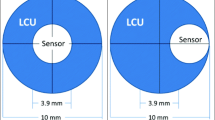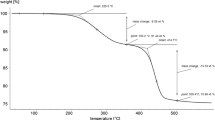Abstract
Objectives
This study aimed to assess the effects of fiber incorporation on the contraction stress (CS), time to gelation (TG), and temperature rise (TR) features of two experimental resin-based composites (RBCs) in comparison to those of bulk-fill RBCs and conventional RBCs in simulated, clinically relevant cavities.
Materials and methods
CS over 300 s, TG and TR were assessed by a stress-strain analyzer (SSA T80) in two cavity configurations (2 × 4 × 4 mm3/4 × 4 × 4 mm3/configuration value \( \raisebox{1ex}{$1$}\!\left/ \!\raisebox{-1ex}{$2$}\right. \) and \( \raisebox{1ex}{$1$}\!\left/ \!\raisebox{-1ex}{$3$}\right. \)) for two experimental RBCs, eight bulk-fill RBCs (EverX Posterior, Filtek Bulk Fill, SDR, SonicFill, Tetric EvoCeram Bulk Fill, Venus Bulk Fill, X-tra base, and X-tra Fill) and one RBC (Filtek Supreme XTE) by light curing (1200 mW/cm2) (n = 10). The experimental materials used were based on EverX Posterior with modifications made to the fiber and filler content. Statistical analyses were performed via ANOVA; multiple pair-wise comparisons were performed via Tukey’s test, and homogeneous subsets were identified (“multcomp” package, R).
Results
CS values ranged from 1.00 to 4.07 MPa (2 × 4 × 4 mm3) and from 0.97 to 2.49 MPa (4 × 4 × 4 mm3); TG values ranged from 1.31 to 4.05 s (2 × 4 × 4 mm3) and from 1.39 to 3.84 s (4 × 4 × 4 mm3). SDR values showed lowest stress values in both cavity configurations. The experimental composite with fibers presented significantly higher stress values than did the experimental composite without fibers.
Conclusion
Bulk-fill RBCs showed lower levels of stress than did conventional RBCs. The incorporation of fibers had no positive impact on the CS and TG.
Clinical relevance
Appropriate material selection may be essential to clinical success because certain RBCs exhibit higher CS, TG, and TR values.




Similar content being viewed by others
References
Marchesi G, Breschi L, Antoniolli F, Di Lenarda R, Ferracane J, Cadenaro M (2010) Contraction stress of low-shrinkage composite materials assessed with different testing systems. Dent Mater 26:947–953. https://doi.org/10.1016/j.dental.2010.05.007
Hilton TJ (2002) Can modern restorative procedures and materials reliably seal cavities? In vitro investigations. Part 2. Am J Dent 15:279–289
Versluis A, Tantbirojn D, Pintado MR, DeLong R, Douglas WH (2004) Residual shrinkage stress distributions in molars after composite restoration. Dent Mater 20:554–564. https://doi.org/10.1016/j.dental.2003.05.007
Chen HY, Manhart J, Hickel R, Kunzelmann KH (2001) Polymerization contraction stress in light-cured packable composite resins. Dent Mater 17:253–259
Kanca J 3rd, Suh BI (1999) Pulse activation: reducing resin-based composite contraction stresses at the enamel cavosurface margins. Am J Dent 12:107–112
Davidson CL, Feilzer AJ (1997) Polymerization shrinkage and polymerization shrinkage stress in polymer-based restoratives. J Dent 25:435–440
Peutzfeldt A (1997) Resin composites in dentistry: the monomer systems. Eur J Oral Sci 105:97–116
Goncalves F, Pfeifer CC, Stansbury JW, Newman SM, Braga RR (2010b) Influence of matrix composition on polymerization stress development of experimental composites. Dent Mater 26:697–703. https://doi.org/10.1016/j.dental.2010.03.014
Goncalves F, Kawano Y, Pfeifer C, Stansbury JW, Braga RR (2009) Influence of BisGMA, TEGDMA, and BisEMA contents on viscosity, conversion, and flexural strength of experimental resins and composites. Eur J Oral Sci 117:442–446. https://doi.org/10.1111/j.1600-0722.2009.00636.x
Goncalves F, Kawano Y, Braga RR (2010a) Contraction stress related to composite inorganic content. Dent Mater 26:704–709. https://doi.org/10.1016/j.dental.2010.03.015
Braga RR, Ferracane JL (2002) Contraction stress related to degree of conversion and reaction kinetics. J Dent Res 81:114–118
Porte A, Lutz F, Lund MR, Swartz ML, Cochran MA (1984) Cavity designs for composite resins. Oper Dent 9:50–56
Hansen EK, Asmussen E (1990) Marginal adaptation of resin in relation to application technique and use of a calcium hydroxide liner. Scand J Dent Res 98:558–563
Park J, Chang J, Ferracane J, Lee IB (2008) How should composite be layered to reduce shrinkage stress: incremental or bulk filling? Dent Mater 24:1501–1505. https://doi.org/10.1016/j.dental.2008.03.013
Mehl A, Hickel R, Kunzelmann KH (1997) Physical properties and gap formation of light-cured composites with and without ‘softstart-polymerization’. J Dent 25:321–330
Abbas G, Fleming GJ, Harrington E, Shortall AC, Burke FJ (2003) Cuspal movement and microleakage in premolar teeth restored with a packable composite cured in bulk or in increments. J Dent 31:437–444
Santos AJ, Sarmento CF, Abuabara A, Aguiar FH, Lovadino JR (2006) Step-cure polymerization: effect of initial light intensity on resin/dentin bond strength in class I cavities. Oper Dent 31:324–331. https://doi.org/10.2341/05-37
El-Damanhoury H, Platt J (2014) Polymerization shrinkage stress kinetics and related properties of bulk-fill resin composites. Oper Dent 39:374–382. https://doi.org/10.2341/13-017-L
Benetti AR, Havndrup-Pedersen C, Honore D, Pedersen MK, Pallesen U (2015) Bulk-fill resin composites: polymerization contraction, depth of cure, and gap formation. Oper Dent 40:190–200. https://doi.org/10.2341/13-324-L
Fronza BM, Rueggeberg FA, Braga RR, Mogilevych B, Soares LE, Martin AA, Ambrosano G, Giannini M (2015) Monomer conversion, microhardness, internal marginal adaptation, and shrinkage stress of bulk-fill resin composites. Dent Mater 31:1542–1551. https://doi.org/10.1016/j.dental.2015.10.001
Feilzer AJ, De Gee AJ, Davidson CL (1987) Setting stress in composite resin in relation to configuration of the restoration. J Dent Res 66:1636–1639. https://doi.org/10.1177/00220345870660110601
Bouschlicher MR, Vargas MA, Boyer DB (1997) Effect of composite type, light intensity, configuration factor and laser polymerization on polymerization contraction forces. Am J Dent 10:88–96
Ferracane JL (2013) Resin-based composite performance: are there some things we can't predict? Dent Mater 29:51–58. https://doi.org/10.1016/j.dental.2012.06.013
Leprince JG, Palin WM, Vanacker J, Sabbagh J, Devaux J, Leloup G (2014) Physico-mechanical characteristics of commercially available bulk-fill composites. J Dent 42:993–1000
Garoushi S, Sailynoja E, Vallittu PK, Lassila L (2013) Physical properties and depth of cure of a new short fiber reinforced composite. Dent Mater 29:835–841. https://doi.org/10.1016/j.dental.2013.04.016
Miletic V, Peric D, Milosevic M, Manojlovic D, Mitrovic N (2016) Local deformation fields and marginal integrity of sculptable bulk-fill, low-shrinkage and conventional composites. Dent Mater 32:1441–1451. https://doi.org/10.1016/j.dental.2016.09.011
Ilie N, Kunzelmann KH, Hickel R (2006) Evaluation of micro-tensile bond strengths of composite materials in comparison to their polymerization shrinkage. Dent Mater 22:593–601. https://doi.org/10.1016/j.dental.2005.05.014
Chen HY, Manhart J, Kunzelmann KH, Hickel R (2003) Polymerization contraction stress in light-cured compomer restorative materials. Dent Mater 19:597–602
Guo Y, Landis FA, Wang Z, Bai D, Jiang L, Chiang MY (2016) Polymerization stress evolution of a bulk-fill flowable composite under different compliances. Dent Mater 32:578–586. https://doi.org/10.1016/j.dental.2016.01.009
Kim RJ, Kim YJ, Choi NS, Lee IB (2015) Polymerization shrinkage, modulus, and shrinkage stress related to tooth-restoration interfacial debonding in bulk-fill composites. J Dent 43:430–439. https://doi.org/10.1016/j.jdent.2015.02.002
Ilie N, Kessler A, Durner J (2013) Influence of various irradiation processes on the mechanical properties and polymerisation kinetics of bulk-fill resin based composites. J Dent 41:695–702. https://doi.org/10.1016/j.jdent.2013.05.008
Goracci C, Cadenaro M, Fontanive L, Giangrosso G, Juloski J, Vichi A, Ferrari M (2014) Polymerization efficiency and flexural strength of low-stress restorative composites. Dent Mater 30:688–694. https://doi.org/10.1016/j.dental.2014.03.006
Takahashi H, Finger WJ, Endo T, Kanehira M, Koottathape N, Komatsu M, Balkenhol M (2011) Comparative evaluation of mechanical characteristics of nanofiller containing resin composites. Am J Dent 24:264–270
Tezvergil A, Lassila LV, Vallittu PK (2006) The effect of fiber orientation on the polymerization shrinkage strain of fiber-reinforced composites. Dent Mater 22:610–616. https://doi.org/10.1016/j.dental.2005.05.017
Dewaele M, Truffier-Boutry D, Devaux J, Leloup G (2006) Volume contraction in photocured dental resins: the shrinkage-conversion relationship revisited. Dent Mater 22:359–365. https://doi.org/10.1016/j.dental.2005.03.014
Vallittu PK (2015) High-aspect ratio fillers: fiber-reinforced composites and their anisotropic properties. Dent Mater 31:1–7. https://doi.org/10.1016/j.dental.2014.07.009
Dullin P (1998) Entwicklung eines Mess-Systems zur Untersuchung des Polymerisationsverhaltens von zahnmedizinischen Kompositfüllungswerkstoffen. Diplomarbeit, Fachhochschule Miinchen, Fachbereich Feinwerk-and Microtechnik, Munich
Heid M (1994) Durchhärttiefe von lichthärtenden Kompositen unter Keramik. Dissertation, Friedrich Alexander University Erlangen-Nuremberg
Hickel R, Heid M, Kunzelmann KH, Petschelt A (1992) Durchhärttiefe von lichthärtenden Kompositen unter Keramik. Dtsch Zahnärztl 47:182–185
Uhlig S (2008) Untersuchung der Polymerisationsschrumpfung unter Berücksichtigung des C-Faktorkonzeptes und dem viskoelastischen Verhalten von Kompositen. Dissertation, Ludwig Maximilians University Munich
Tantbirojn D, Versluis A, Pintado MR, DeLong R, Douglas WH (2004) Tooth deformation patterns in molars after composite restoration. Dent Mater 20:535–542. https://doi.org/10.1016/j.dental.2003.05.008
Acknowledgements
We thank GC for kindly providing the experimental materials.
Author information
Authors and Affiliations
Corresponding author
Ethics declarations
Conflict of interest
The authors declare that they have no conflicts of interest.
Ethical approval
This article does not refer to any studies involving human participants or animals performed by the authors.
Informed consent
For this type of study, formal consent is not required.
Rights and permissions
About this article
Cite this article
Keßler, A., Kaisarly, D., Hickel, R. et al. Effect of fiber incorporation on the contraction stress of composite materials. Clin Oral Invest 23, 1461–1471 (2019). https://doi.org/10.1007/s00784-018-2572-1
Received:
Accepted:
Published:
Issue Date:
DOI: https://doi.org/10.1007/s00784-018-2572-1




